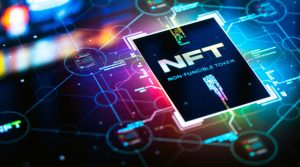Introduction
Non-Fungible Tokens (NFTs) have taken the digital world by storm in recent years, with the sale of NFTs reaching new heights in terms of both monetary value and attention. NFTs are unique digital assets that are stored on a blockchain, and their uniqueness is what sets them apart from other digital assets. They can represent anything from artwork and music to virtual real estate and gaming items. While NFTs have primarily been associated with the art world, they have also been making waves in the realm of Decentralized Finance (DeFi). In this article, we will discuss the role of NFTs in DeFi and their potential impact on the future of finance.
What is DeFi?
Decentralized Finance (DeFi) refers to a set of financial tools and applications built on blockchain technology that aim to provide financial services to anyone with an internet connection. DeFi applications are decentralized, meaning they operate on a peer-to-peer network of computers without the need for intermediaries such as banks or other financial institutions. DeFi protocols enable users to lend, borrow, trade, and invest in a variety of digital assets, such as cryptocurrencies and stablecoins. These applications are often open source, meaning anyone can access and use them, and they are generally more transparent and accessible than traditional financial systems.
NFTs in DeFi
NFTs have the potential to play a significant role in DeFi because they offer a unique way to represent ownership and value on the blockchain. In traditional finance, ownership and value are represented by physical assets such as property or stocks. In DeFi, ownership and value are represented by digital assets such as cryptocurrencies and stablecoins. NFTs take this concept one step further by enabling users to represent ownership and value in unique, non-interchangeable digital assets.
One way NFTs are being used in DeFi is as collateral for loans. Traditionally, lenders require collateral to secure loans, and borrowers must provide collateral that has a value equal to or greater than the amount borrowed. In DeFi, borrowers can use NFTs as collateral for loans. This is because NFTs are unique and can be verified on the blockchain, making them valuable assets that can be used to secure loans.
Another way NFTs are being used in DeFi is in the creation of decentralized marketplaces. NFT marketplaces enable users to buy, sell, and trade unique digital assets, such as artwork and gaming items, using cryptocurrencies. These marketplaces are decentralized, meaning there is no central authority or intermediary involved in the buying and selling process. NFT marketplaces are becoming increasingly popular, and some are even being used to sell high-value items, such as virtual real estate and domain names.
Finally, NFTs are also being used to create new DeFi products and services. For example, NFTs can be used to create new forms of insurance or derivatives that are unique and tailored to individual users’ needs. NFTs can also be used to represent ownership in decentralized autonomous organizations (DAOs), which are organizations that operate on a blockchain and are run by a community of users rather than a central authority.
Challenges of NFTs in DeFi
While NFTs have the potential to revolutionize DeFi, there are also some challenges that must be addressed. One challenge is the high gas fees associated with NFT transactions. Gas fees are fees paid by users to miners to process transactions on the blockchain. NFT transactions can be expensive because they require a significant amount of data to be stored on the blockchain, and this data requires more computational power to process. High gas fees can make NFT transactions prohibitively expensive, especially for smaller transactions.
Another challenge is the lack of liquidity for NFTs. Liquidity refers to the ease with which an asset can be bought or sold without affecting its market price. NFTs can be illiquid because they are unique, meaning there may be a limited number of buyers and sellers for a particular NFT. This can make it difficult to determine the fair market value of an NFT and can make it harder to buy or sell NFTs.
In addition, the lack of standardized metadata for NFTs can make it difficult for buyers and sellers to determine the provenance and authenticity of an NFT. There is currently no standardized way to attach metadata to NFTs, and this can lead to confusion and potential fraud. It is important for buyers and sellers to verify the authenticity and provenance of an NFT before making a purchase.
One potential solution to the challenges facing NFTs in DeFi is the development of Layer 2 solutions. Layer 2 solutions are protocols built on top of existing blockchains that enable faster and cheaper transactions. These protocols can help reduce the high gas fees associated with NFT transactions, making them more accessible to a wider range of users. Layer 2 solutions can also help increase the liquidity of NFTs by enabling faster and more efficient trades.
Another potential solution is the development of standardized metadata for NFTs. Standardized metadata can help increase transparency and reduce the potential for fraud by providing a consistent and verifiable way to attach information to NFTs. This can help buyers and sellers verify the authenticity and provenance of NFTs and can increase confidence in the market.
Finally, it is important for regulators to carefully consider the role of NFTs in DeFi and to develop appropriate regulations to protect consumers and ensure the integrity of the market. NFTs in DeFi are still a new and emerging technology, and it is important for regulators to stay informed and adapt as the market evolves.
Conclusion
NFTs have the potential to transform the way we think about ownership and value in DeFi. While there are challenges that must be addressed, such as high gas fees and illiquidity, there are also potential solutions, such as Layer 2 solutions and standardized metadata. As the market for NFTs in DeFi continues to evolve, it will be important for users, developers, and regulators to work together to ensure that this new technology is used responsibly and ethically. With careful consideration and thoughtful development, NFTs in DeFi have the potential to revolutionize the financial landscape for years to come.





